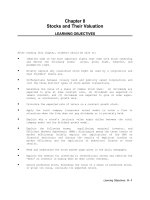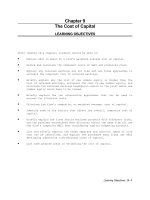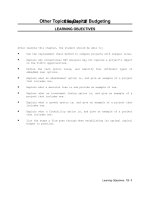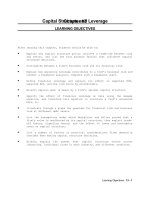Financial managment Solution Manual: Time Value of Money
Bạn đang xem bản rút gọn của tài liệu. Xem và tải ngay bản đầy đủ của tài liệu tại đây (74.13 KB, 5 trang )
6-1 0 1 2 3 4 5
| | | | | |
PV = 10,000 FV
5
= ?
FV
5
= $10,000(1.10)
5
= $10,000(1.61051) = $16,105.10.
FV = PV(FVIF) = 10,000*1.6105 = $16,105
6-2 0 5
10 15 20
| | | | |
PV = ? FV
20
= 5,000
PV=FV(PVIF) = 5,000(.2584) = $1,292
6-3 0 n = ?
| |
PV = 1
FV
n
= 2
2 = 1(1.065)
n
.
You could try out different n’s and solve this by trial and error.
With a financial calculator enter the following: I = 6.5, PV = -1, PMT =
0, and FV = 2. Solve for N = 11.01 ≈ 11 years.
Using tables: 2=1(FVIF
6.5%, n
)
FVIF
6.5%, n
= 2
In the FVIF Table, look in the 6% and 7% columns and find the n where the
FVIFs “bracket” 2.0.
FVIF@6% for 11yrs = 1.8983
FVIF@7% for 11 yrs = 2.1049
Estimated n = 11 yrs.
Answers and Solutions: 6 - 1
Chapter 6
Time Value of Money
SOLUTIONS TO END-OF-CHAPTER PROBLEMS
10%
7%
6.5%
6-6 0 1 2 3 4 5
| | | | | |
300 300 300 300 300
FVA
5
= ?
With a financial calculator enter the following: N = 5, I = 7, PV = 0,
and PMT = 300. Solve for FV = $1,725.22.
FVA = PMT*FVIFA
7%, 5
= $300*5.7507 = $1,725.21
6-10 a. 1997 1998 1999 2000 2001 2002
| | | | | |
-6 12 (in millions)
With a calculator, enter N = 5, PV = -6, PMT = 0, FV = 12, and then
solve for I = 14.87%.
FV = PV*(FVIF
g, 5
)
12 = 6*(FVIF
g, 5
)
FVIF
g, 5
= 2.0
Look in the table for 2.0 on the n = 5 row: g = approx. 15%
b. The calculation described in the quotation fails to take account of the
compounding effect. It can be demonstrated to be incorrect as follows:
$6,000,000(1.20)
5
= $6,000,000(2.4883) = $14,929,800,
which is greater than $12 million. Thus, the annual growth rate is less
than 20 percent; in fact, it is about 15 percent, as shown in Part a.
6-11 0 1 2 3 4 5 6 7 8 9
10
| | | | | | | | | | |
-4 8 (in millions)
With a calculator, enter N = 10, PV = -4, PMT = 0, FV = 8, and then solve
for I = 7.18%.
FV = PV*FVIF
i, 10
8 = 4*FVIF
i, 10
2 = FVIF
i,10
Look in the n = 10 row for 2.0.
2.0 is between 1.9672 @ 7% and 2.1589 @ 8%
The “distance” from 7% to 8% is 1%. The “distance” for 1.9672 to 2.1589
is .1917. The distance from 1.9672 to 2.0 is .0328. The “distance” from
7% to i is x. Solve for x by interpolation:
Answers and Solutions: 6 - 2
7%
?
i = ?
.01/.1917 = x/.0328
.01*.0328 = .1917*x
.000328 = .1917x
x = .0017 or .17%
i = 7% + x = 7.17%
6-12 0 1 2 3 4 30
| | | | | • • • |
85,000 -8,273.59 -8,273.59 -8,273.59 -8,273.59 -8,273.59
With a calculator, enter N = 30, PV = 85000, PMT = -8273.59, FV = 0, and
then solve for I = 9%.
Using the tables:
PVA=PMT*PVIFA
i, n
85000 = 8,273.59*PVIVA
i, 30
PVIFA
i, 30
=10.2737
From the PVIFA table i = 9%
6-13 a. 0 1 2 3 4
| | | | |
PV = ? -10,000 -10,000 -10,000 -10,000
With a calculator, enter N = 4, I = 7, PMT = -10000, and FV = 0. Then
press PV to get PV = $33,872.11.
PVA=PMT*PVIFA
7%, 4
=10,000*3.3872
=$33,872
b. 1. At this point, we have a 3-year, 7 percent annuity whose value is
$26,243.16. You can also think of the problem as follows:
$33,872(1.07) - $10,000 = $26,243.04.
2. Zero after the last withdrawal.
6-16 PV = $100/0.07 = $1,428.57. PV = $100/0.14 = $714.29.
When the interest rate is doubled, the PV of the perpetuity is halved.
6-20 a. Begin with a time line:
Answers and Solutions: 6 - 3
i = ?
7%
0 1 2 3 4 5 6 7 8 9 10 16 17 18 19 20 6-
mos.
0 1 2 3 4 5 8 9 10 Years
| | | | | | | | | | |
• • •
| | | | |
100 100 100 100 100 FVA
Since the first payment is made today, we have a 5-period annuity due.
The applicable interest rate is 12%/2 = 6%. First, we find the FVA of
the annuity due in period 5 by entering the following data in the
financial calculator: N = 5, I = 12/2 = 6, PV = 0, and PMT = -100.
Setting the calculator on “BEG,” we find FVA (Annuity due) = $597.53.
Now, we must compound out for 15 semiannual periods at 6 percent.
$597.53 20 – 5 = 15 periods @ 6% $1,432.02.
Using the tables: We can solve this in four steps.
1. Calculate the FV in 10 yrs (20 periods) of the $100 PMT made
today: FV
20
=PV*FVIV
6%. 20
= 100*3.2071=$320.71
2. Calculate FVA as of period 4 of the ordinary annuity that begins
at t=1 and ends at t=4: FVA
4
=PMT*FVIFA
6%, 4
= 100*4.3746 = $437.46
3. Calculate the FV in 16 periods (@the end of yr 10_of the $437.46
lump sum amt (PV)at the end of period 4:
FV
16
= PV*FVIF
6%. 16
= $437.46*2.5404 = $1111.32
4. Add up the two FV amts. FV = 320.71 + 1111.32=$1,432.03
b. 0 1 2 3 4 5 40 quarters
| | | | | | • • • |
PMT PMT PMT PMT PMT
FV = 1,432.02
The time line depicting the problem is shown above. Because the
payments only occur for 5 periods throughout the 40 quarters, this
problem cannot be immediately solved as an annuity problem. The
problem can be solved in two steps:
1. Discount the $1,432.02 back to the end of Quarter 5 to obtain the PV
of that future amount at Quarter 5.
Input the following into your calculator: N = 35, I = 3, PMT = 0,
FV = 1432.02, and solve for PV at Quarter 5. PV = $508.92.
2. Then solve for PMT using the value solved in Step 1 as the FV of the
five-period annuity due.
The PV found in step 1 is now the FV for the calculations in this
step. Change your calculator to the BEGIN mode. Input the
Answers and Solutions: 6 - 4
6%
3%
following into your calculator: N = 5, I = 3, PV = 0, FV = 508.92,
and solve for PMT = $93.07.
Answers and Solutions: 6 - 5









